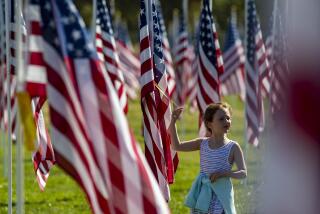County Amateur Radio Operators Ham It Up for Nationwide Event : Communication: The annual Field Day competition is intended to hone skills necessary in relaying vital information during natural disasters.
- Share via
COSTA MESA — With an almost imperceptible twist of his radio tuner, Ben Hathaway picked out the thin-sounding voice from a cacophony of static, buzzes and whistles.
“CQ Field Day, CQ Field Day, this is Kilo-Eight-November-India,” the voice of an Ohio-based ham operator said over Hathaway’s powerful, high-frequency radio. “Anyone out there?”
Hathaway hurriedly jotted down the operator’s call sign on a scratch pad and then responded in a clipped monotone voice: “This is November-Six-Frank-Mexico, N-6-F-M. Over.”
“What section (of the country) are you in? Over,” the voice asked.
“In Orange,” Hathaway answered.
“How do you abbreviate that?”
“O-R-G. Over,” Hathaway said.
“OK, orgy,” the voice joked back. “See ya later, and good luck. Ohio out.”
That quick, long-distance exchange was one of millions expected during a 24-hour period that began Saturday morning as licensed ham radio operators around the country tuned in to participate in the annual Field Day.
Sponsored by the American Radio Relay League, Field Day is held each year to hone the skills of amateur radio operators, who are often called upon to relay vital information during major earthquake, hurricane, tornado or other disasters.
So beginning at 11 a.m. Saturday, many of the 475,000 licensed ham radio operators in the United States flipped on their ham radio gear and feverishly began scanning the airwaves to make contact with other amateur radio buffs.
Speed, as well as the ability to use Morse code and set up emergency radio equipment, was tested throughout the day.
Hathaway, a communications technician for the city, was one of 25 members of the Costa Mesa-sponsored Mesa Emergency Service Amateur Communications (MESAC) ham operators club who manned four transmitters set up in a parking lot at the corner of Newport Boulevard and Fair Drive promptly at 11 a.m.
And while thousands enjoyed a summery day off at the Orange County Fairgrounds swap meet across the street, the small band of MESAC die-hards settled under blue makeshift tents to spend a grueling 24 hours on the air, cataloguing as many contacts with other ham operators as they could.
“We want to be ready in case there’s an emergency,” said Costa Mesa Police Sgt. Matt Collett, a five-year ham operator and organizer of MESAC’s participation in the national event.
The MESAC group was one of six amateur radio groups in Orange County that set up field stations, complete with solar panels and generators. In fact, running a field station independently of commercial electricity was the main point of the exercise, Collett said.
“We wouldn’t even know that the power is off,” he said. “We could stay on the air no matter what happens.”
Field Day is also a contest of sorts, in which the radio club that makes the most contacts in 24 hours earns no reward but the satisfaction of knowing it is ready when it is needed.
In Costa Mesa, each contact made throughout the 24-hour period was jotted down on a sheet of paper and was worth one point.
The winning amateur radio group will be recognized two months from now by the ARRL, said Gorden West, a longtime ham radio operator and instructor who helped organize the MESAC participation.
It was the first time that MESAC, sponsored by the Police Department as well as the city, participated in the yearly exercise, which was initiated after World War II.
West said that although ham operators over the years have acquired a reputation of being “rag chewers” on the air, talking for hours with airwave buddies from around the world, the exercise illustrates the serious side of the hobby.
In fact, West said, he made contact Friday night with a ham radio operator transmitting just outside the earthquake-stricken area in northern Iran.
“He told us that the 25,000 (dead) may be greatly underestimated,” West said. “The damage is much greater than they first thought.”
Last year, within minutes of the first shock wave that shook the Bay Area, West said, he contacted a ham operator in Santa Cruz who was calling for help. West passed on emergency information, including names of survivors, supplied by the radio operator.
“Amateur radio allows us to bridge any gap,” West said. And because amateur ham operators are not as confined as professional radio operators, he said, “they are more willing to try new and different things,” such as novel antenna configurations and experimental radio equipment.
“It’s a lot of fun,” he said.
More to Read
Sign up for Essential California
The most important California stories and recommendations in your inbox every morning.
You may occasionally receive promotional content from the Los Angeles Times.













